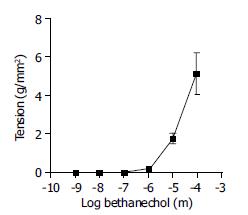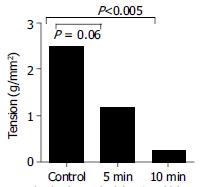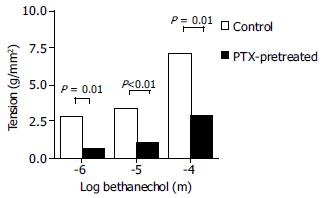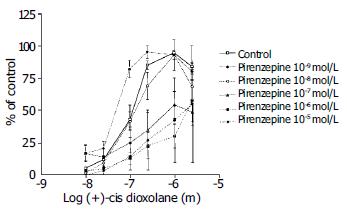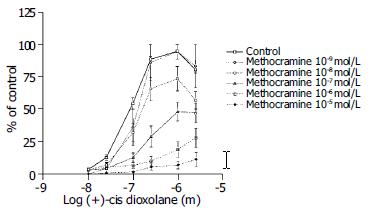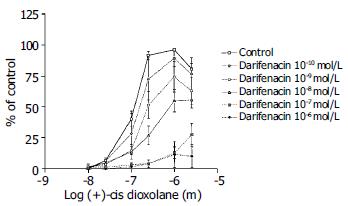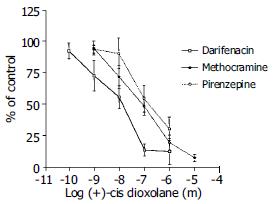Copyright
©The Author(s) 2004.
World J Gastroenterol. Nov 15, 2004; 10(22): 3292-3298
Published online Nov 15, 2004. doi: 10.3748/wjg.v10.i22.3292
Published online Nov 15, 2004. doi: 10.3748/wjg.v10.i22.3292
Figure 1 Effect of bethanechol on smooth muscle contraction.
Antrum circular smooth muscle strips were incubated with increasing concentrations of bethanechol (10-4 mol/L to 10-7 mol/L). The vertical axis represents the developed tension (in grams per mm2). Bethanechol significantly increased circular muscle tension (P < 0.05; paired t-test). Each data point represents mean ± SE, n = 4.
Figure 2 Effect of depletion of Ca2+ from medium on the contraction of antral circular smooth muscle strips to bethanechol (10-4 mol/L).
Ca2+ depletion caused a significant decrease in the muscle tension; after 5 min incubation (P < 0.06, paired t-test); and after 10 min incubation (P < 0.005, paired t-test) compared to the base contraction induced by bethanechol before Ca2+ depletion. Each data point represents mean ± SE, n = 3.
Figure 3 Effect of PTX on antrum circular smooth muscle strips contraction to bethanechol (10-4 mol/L to 10-6 mol/L).
PTX significantly inhibited the contractile activity of the smooth muscle (P ≤ 0.01; paired t-test) compared to control rats. Each point represents mean ± SE, n = 7; dotted bars represent control animals; solid bars-PTX-pretreated animals.
Figure 4 Effect of PTX on dispersed antral circular smooth muscle myocytes from PTX-pretreated rats contraction to bethanechol (10-7 mol/L and 10-8 mol/L).
Myocytes from PTX-treated rats contracted less than myocytes from control rats. Each point represents mean ± SE; of the percentage of the control cells diastolic length (no bethanechol). At least 50 myocytes per point were calculated, P < 0.005; n = 7 and 11. Dotted bars represent control animals; solid bars PTX-pretreated animals.
Figure 5 Concentration-response curves for the contractile effect of (+)-cis-Dioxolane alone and in combination with different concentrations of M1 antagonist, pirenzepine (10-8 mol/L to 10-5 mol/L) on the rat antral circular smooth muscle strips.
Each point represents the mean ± SE, n = 6, 6, 7 and 8 strips. Cumulative concentration-effect curve was constructed for each strip for (+)-cis-Dioxolane, (10-8 to 3 × 10-5 mol/L). After washing, strips were equilibrated in either the absence (control) or presence of pirenzepine for 90 min. Subsequently, the second concentration-effect curve for (+)-cis-Dioxolane was constructed for each strip. Pirenzepine caused a significant inhibition of the contractile muscle response to (+)-cis-dioxolane.
Figure 6 Concentration-response curves for the contractile effect of (+)-cis-Dioxolane alone and in combination with different concentrations of M2 antagonist, methocramine (from 10-8 mol/L to 10-5 mol/L) on the rat antral circular smooth muscle strips.
Each point represents the mean ± SE; n = 4, 9, 10 and 11 strips. First, cumulative concentration-effect curve was constructed for each strip for (+)-cis-Dioxolane, (10-8 to 3 × 10-5 mol/L). After washing, tissues were equilibrated in either the absence (control) or presence of methocramine for a 90 min. Subsequently, the second concentration-effect curve for (+)- cis-Dioxolane was constructed for each strip. Methocramine caused a significant inhibition of the contractile muscle response to (+)-cis-Dioxolane.
Figure 7 Concentration-response curves for the contractile effect of (+)-cis-Dioxolane alone and in combination with different concentrations of M3 antagonist, darifenacin (from 10-10 mol/L to 10-6 mol/L) on the rat antral circular smooth muscle strips.
Each point represents the mean ± SE; n = 4, 7, 11, 10 strips. First, cumulative concentration-effect curve was constructed for each strip for (+)-cis-Dioxolane, (10-8 to 3 × 10-5 mol/L). After wash, tissues were equilibrated in either the absence (control) or presence of darifenacin for a 90 min. Subsequently, the second concentration-effect curve for (+)-cis-Dioxolane was constructed for each strip. Darifenacin caused a significant inhibition of the contractile muscle response to (+)-cis-Dioxolane.
Figure 8 Comparison of the inhibition of the contractile response to cis-Dioxolane by 3 muscarinic receptor antagonists: M3- darifenacin, M2- methocramine, and M1- pirenzepine.
The M3 antagonist, darifenacin, was the most potent inhibitor of the contraction induced by (+)-cis Dioxolane (10-6 mol/L). The EC50 values for each were: for darifenacin (M3) -7.9; for methocramine (M2) -7.2; and for pirenzepine (M1) -6.8.
- Citation: Wrzos HF, Tandon T, Ouyang A. Mechanisms mediating cholinergic antral circular smooth muscle contraction in rats. World J Gastroenterol 2004; 10(22): 3292-3298
- URL: https://www.wjgnet.com/1007-9327/full/v10/i22/3292.htm
- DOI: https://dx.doi.org/10.3748/wjg.v10.i22.3292









